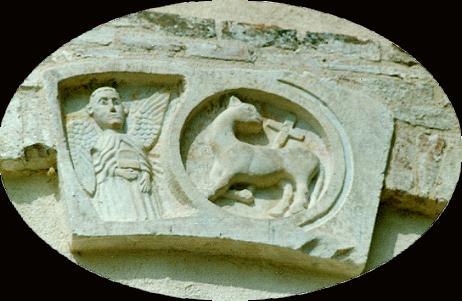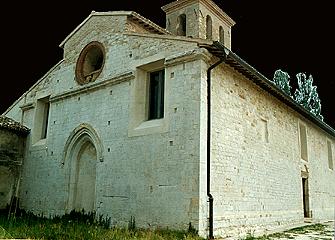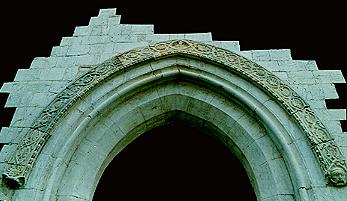L’antica chiave di volta absidale di S. Maria in Campis presso Beroide (PG).

La chiesa di
S. Maria in Campis presso Beroide sorge, come espresso dal nome, in una
situazione agreste, ovvero in un territorio pianeggiante fittamente
coltivato.
L’edificio ha
subito numerose ristrutturazioni che ne hanno assai alterato le strutture
medievali. Infatti l’abside antico è andato distrutto mentre l’ingresso ad arco
gotico è ora murato, in quanto sostituito da un altro
laterale.
In queste
manomissioni, la pietra che costituiva la chiave di volta dell’arco trionfale, è
stata evidentemente girata, in modo da essere ora visibile dall’esterno, ove si
notano i segni della presenza dell’arco absidale.
La pietra
mostra le immagini scolpite di un angelo che tiene un libro in mano e di un
agnello “crocifero”.
Si tratta
quindi di un riferimento ai passi dell’Apocalissi giovannea 21,
22 e ss. e 22 in cui si cita l’Agnello, che è il Cristo
glorioso, il quale farà da lampada perenne alla Città divina. In particolare,
poi, 22,6 riporta: E [l’angelo] mi [cioè a Giovanni] disse:
<<[…] il Signore Iddio degli spiriti de’ profeti ha mandato il suo
angelo a mostrare a’ suoi servi ciò che deve accader tra breve: Ecco ch’io vengo
presto! Beato chi osserva le parole della profezia di questo
libro>>.
Quindi,
venendo al simbolismo espresso dalla piccola scultura, si può notare come
l’Agnello, rappresentato in un cerchio al culmine dell’apertura
absidale, non faccia appunto che rappresentare la”lampada” della Città
divina.
In relazione a
questo, si può dedurre che, nel caso, l’abside ora distrutta era intesa -nella
concezione simbolica generale della chiesa - quale immagine della Gerusalemme
celeste.
Pare quindi
possibile supporre che la pianta absidale fosse di forma quadrilatera,
coerentemente con la forma della Città celeste descritta
nell’Apocalissi.
Da notare è comunque il fatto che si sia scelto di porre l’immagine dell’Agnello al culmine dell’ arco e non al centro della volta dell’abside stessa, come solitamente avviene http://spazioinwind.libero.it/iconografia/Agnelloabside.htm ; è probabile che con questo si sia inteso sottolineare il rapporto tra “pietra d’altare” e “chiave di volta” in quanto quest’ultima si trovava con ogni probabilità in posizione perpendicolare alla prima (1).
Non si esclude
di tornare su questo tema in un prossimo breve scritto.
(1)Sul
significato simbolico della chiave di volta, vedi: J. Hani, Il
simbolismo del tempio cristiano, Roma 1996, pp.122 – 123. Anche: R.
Guenon, Simboli della scienza
sacra, Milano, 1975, pp. 238 – 250.
The ancient keystone of the apse of S. Maria in Campis near Beroide (Perugia, Umbria).

The church of
S. Maria in Campis near Beroide rises, as its name clarifies, in countryside, in
a wide plot.
This
building underwent many changes that modified its medieval
shape.
For
istance, the ancient apse was destroyed while the main gate with a gothic arch
was closed and replaced by a side entrance.
During
these changes, the keystone of the original arch of the apse was moved and now
it is visible from outside, where you can see the rests of the arch.
The
stone shows the sculpted pictures of an angel keeping a book and of a lamb with
the cross.
They
are clear references to the passages of St. John’s Apocalypse
(21, 22 and 22) where there is the quotation
of the Lamb that’s Jesus in his Glory who will be light for the Divine
City.
Particularly
22,6-7 refers:
<<[…]and the Lord God of the holy prophets sent his angel to
shew unto his servants the things which must shortly be done.
Behold, I
come quickly: blessed is he that keepeth the sayings of the prophecy of this
book.>>.
So, as far as
the symbolism of the sculptures is concerned, you can notice that the Lamb, that
was on the top of the arch of the apse, represents nothing but the light of the
Divine City.
For
this reason, it’s possible to deduce that, in the symbolical dimension of this
church, the apse was originally conceived as “image” of the New Jerusalem.
It seems also
possible to think that the plan of the – now disappeared – apse was
quadrilateral in relationship with the shape of the Celestial City, as it is
described in the Apocalypse.
It
can be even added that the position of the picture of the Lamb at the top of the arch
- instead of centre of the apsidal vault as usually happens
http://spazioinwind.libero.it/iconografia/Agnelloabside.htm
- is quite interesting. Maybe, in this way
they wanted to underline the relationship between the keystone and the stone of
the altar that was probably just below the arch itself
(1) .
A future
outline on this website could deal with this subject.
(1) The symbolical meaning of the keystone is dealt with in: J. Hani, Il simbolismo del tempio cristiano, Roma 1996, pp.122 – 123.See even: R. Guenon, Simboli della scienza sacra, Milano, 1975, pp. 238 – 250.
